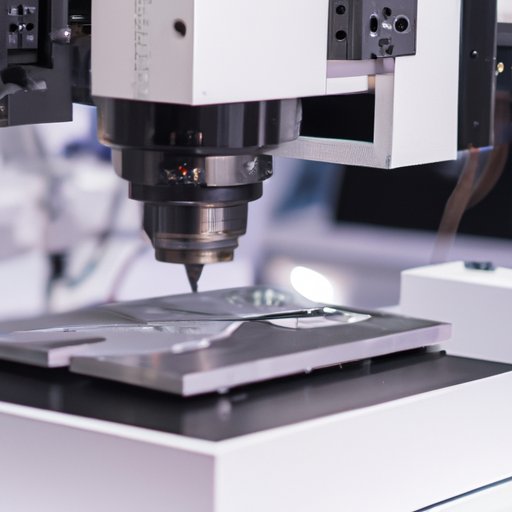Introduction
Examining metal surfaces using microscopes is an essential aspect of metallurgy. Metallurgists use this technique to identify features on metal surfaces, understand material properties and quality, and troubleshoot issues. This article will explore the essential microscope used for examining metal surfaces and discuss various aspects surrounding this process, from choosing the right microscope to comparing different types of microscopes and understanding their anatomy and functionality.
The Essential Microscope for Examining Metal Surfaces: A Comprehensive Guide
The essential microscope used for examining metal surfaces is a metallographic microscope. This type of microscope comes with specialized features that allow it to view metal samples at high magnification and produce detailed images.
One of the most critical features of a metallographic microscope is its ability to view a material’s microstructure. For metallurgists, being able to see the microstructure of a material is vital in understanding how a material behaves under certain conditions, how it was made, and what defects it may contain.
Another important aspect of a metallographic microscope is its reflective and illuminating abilities. Most materials, including metals, are reflective, and it can be challenging to view their features without proper illumination. A metallographic microscope comes equipped with specialized lighting that helps ensure that the features on a metal surface are highlighted accurately.
Choosing the Right Microscope for Metal Surface Analysis: An Expert’s Point of View
Choosing the right microscope for metal surface analysis can be challenging, especially for those without prior experience. However, certain factors can help individuals make informed decisions.
One of the most critical factors to consider is the application in which the microscope will be used. The requirements for metal surface analysis in manufacturing are significantly different from those used in metallurgy, whereas analyzing wear patterns on a material surface has different requirements altogether. Knowing the exact requirements of a microscope’s application will help streamline the search, reduce costs, and achieve better results.
Other factors to consider include the magnification range, depth of field, focus range, quality of optics, and the microscope’s overall ergonomics. When in doubt, seeking the help of an expert in the field can help an individual make a better-informed decision and reduce any confusion or complications that may arise.
Comparing Different Types of Microscopes for Viewing Metal Surfaces
While metallographic microscopes are the most common option for examining metal surfaces, several other types of microscopes are available within the field. Each of these microscopes offers its own set of advantages and disadvantages.
One of the most common types of microscopes used for metal surface analysis is the scanning electron microscope (SEM). SEMs produce high-resolution images by transmitting electrons to the sample surface, providing exceptional detail on the material’s features. However, SEMs are costly and require specialized users.
Another option is the optical microscope, which relies on visible light to produce images. The resolution of these microscopes is limited compared to SEMs, but they are easier to use and significantly more affordable.
Why Metallurgists Rely on this Type of Microscope for Surface Analysis
Metallurgists rely on metallographic microscopes because of their ability to produce detailed and accurate images of a material’s microstructure. These images provide metallurgists with insights into how a material was made, how its properties can change under different conditions, and what type of defects and discontinuities it may contain.
Other advantages of using a metallographic microscope include its ability to analyze grain size, examine microcracks, view surface features, and produce quantitative and qualitative analysis of various metal surfaces.
Tools of the Trade: Understanding Microscopes for Inspecting Metal Surfaces
Before understanding the anatomy and functionality of a microscope used in metal surface analysis, it is essential to know how a microscope works. Microscopes rely on a combination of lenses, light sources, and electronic components to produce images. The user can adjust different parameters, such as magnification, depth of field, focus, lighting, and more, to achieve the desired results.
The main components of a microscope include the eyepiece, objective lenses, stage, light source, and focus knob. The eyepiece is where the user views the magnified image, and the objective lens is the primary lens that produces the magnified image. The stage is where the sample is placed, and the light source illuminates the sample to produce clear images. The focus knob allows the user to control the clarity of the image by adjusting the distance between the lenses and the sample.
How Microscopic Examination of Metal Surfaces Can Improve Quality Control in Manufacturing
Microscopic examination of metal surfaces is an essential process in almost every manufacturing industry. This process allows manufacturers to identify defects, improve performance, refine processes, and ensure that quality control standards are met.
One example of how microscopic examination of metal surfaces has improved quality control standards in manufacturing is in the production of engine components. Examining the surface of engine components under a metallographic microscope allows manufacturers to identify any defects, discontinuities, or signs of wear. By identifying any defects early on, manufacturers can reduce downtime, prevent product recalls, and improve overall product quality.
Conclusion
In conclusion, examining metal surfaces using a microscope is an essential aspect of metallurgy, manufacturing, and other related fields. Choosing the right microscope, comparing different types of microscopes, and understanding their anatomy and functionality can help provide valuable insights into material properties and improve quality control standards. We encourage readers to use this information to make informed decisions when examining metal surfaces and to further explore the field of metal surface analysis.
